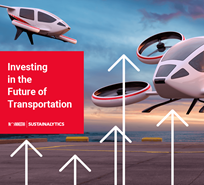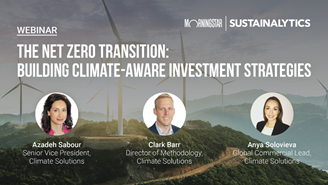Will SVB’s Failure Create Headwinds in Clean Technology?
SVB's failure could create a domino effect in the IT and banking sectors, whereby the default of one company would trigger the default of another one across sectors, and so on. In this article, we explore that possibility for the cleantech sector.
A New Tool at the Table: Understanding Low Carbon Transition Risk By Industry and How Companies Are Managing It
Discover how leading companies are managing their low carbon transition risks. Using data from the Low Carbon Transition Ratings, we identify the industries with a large portion of the companies with strong management of transition issues and examine the factors contributing to their strong management scores.
EU's Iterative Approach to Sustainable Finance Regulations Isn't Perfect, But It's a Good Start
The EU Action Plan for Sustainable Finance has kept the European investment market busy over the past year. In this blog post, we highlight the merits that we see in the EU regulatory package. While not perfect, the regulation is a good start.
Carbon Emissions Data for Investors: Closing the Reporting Gap and Future-Proofing Estimations
Despite improvements in the quality and quantity of carbon emissions reporting from companies, significant gaps remain. Discover the current state of emissions disclosures, learn the advantages and disadvantages of widely used estimation models, and discover the approach underpinning Sustainalytics' Carbon Emissions Data product.
On the Path to Compliance: An EU Action Plan Timeline
As the EU Action Plan’s legislative framework is being formalized and implemented, many investment firms may still need clarity on its regulations and terminology. In this blog, we demystify 10 key terms to help you better understand the EU Action Plan.
Physical Climate Risk: Preparing Your Portfolio for a Changing Climate
The physical climate risks affecting assets are likely to increase in the coming years, as the impacts of climate change are felt more frequently and with more intensity. In this guide, learn how companies and investors can assess their exposure to physical climate risks.
On-Demand Webinar: Cyberattacks, Corporate Exposure, and Material ESG Risk
Data privacy and cybersecurity-related issues have become major drivers of business risk in recent years. Cyber risk is “the most immediate and financially material sustainability risk that organizations face today,” according to the World Economic Forum.
The EU Action Plan on Financing Sustainable Growth: Twelve Essential Questions Answered for Investors
Learn what the EU Action Plan is, its objectives, and the importance of taking immediate action to comply with its various regulations including the EU Taxonomy Regulation, Sustainable Finance Disclosure Regulation, and the EU Benchmarks Regulation.
Physical Climate Risks: 6 Things Portfolio Managers Need to Know
The negative physical impacts of climate change are being felt by communities and corporations globally and are likely to get worse in the coming years. The knock-on costs of more frequent “once-in-a-century” climate events on economies are likely to rise. To prepare for this looming threat, investors must forecast the asset-level effects of climate change on companies in a granular and sophisticated way. Here are six things portfolio managers should know to manage and mitigate the physical risks of climate change to their portfolios and meet growing list of climate-focused reporting requirements.
ESG Risks Affecting Data Centers: Why Water Resource Use Matters to Investors
Data centers play a critical role for many technology and telecom companies and for their supporting servers, digital storage equipment and network infrastructure for data processing and storage. Data centers require high volumes of water directly for cooling purposes and indirectly, through electricity generation. Morningstar Sustainalytics’ recent activation of the Resource Use Material ESG Issue (MEI) within its ESG Risk Ratings recognizes water risks of data centers.
Impact of US Supreme Court’s EPA Ruling on US Utilities’ Carbon Exposure
The Clean Power Plan was created using a directive from the Clean Air Act that enabled the EPA to set emission limits for air pollutants based on the best available technology to reduce emissions. The EPA aimed to cap carbon emissions and curb greenhouse (GHG) emissions by changing the composition of the existing operational power generation assets by forcing the closure of coal plants through strict emission caps, resulting in a system-wide transition to renewable energy.








.png?sfvrsn=2eecdd86_0)

.tmb-thumbnl_rc.png?Culture=en&sfvrsn=32dbabe_4)



.tmb-thumbnl_rc.png?Culture=en&sfvrsn=3b0e4598_4)
.tmb-thumbnl_rc.png?Culture=en&sfvrsn=4c162f31_4)





